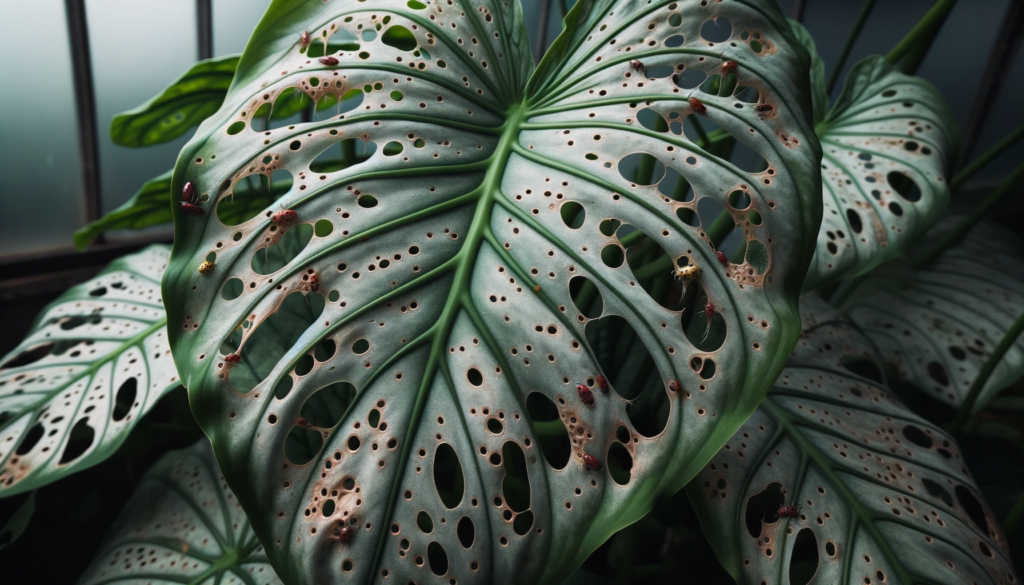Table of Contents
Introduction to the Swiss Cheese Plant
Buy This Premium Website for Only $899 !
Acquire a high-authority website complete with content and a premium domain name.
Contact Us Today: Email: info@cleardesign.ch
The allure of the Swiss Cheese Plant is undeniable. With its captivating perforated leaves, it brings a slice of the tropics right into our homes. Known scientifically as Monstera deliciosa, this plant isn’t just about aesthetics; it’s also lauded for being relatively low-maintenance. As we delve deeper into its world, we’ll uncover its historical roots, its botanical specifics, and some personal insights on nurturing it to its full splendor.
Historical Background of the Swiss Cheese Plant
Hailing from the dense rainforests of Central America, the Swiss Cheese Plant boasts a heritage that’s as rich as its vibrant green leaves. In its wild habitat, it often adopts an epiphytic lifestyle, gracefully draping itself over larger trees while reaching upwards for sunlight. Ancient records highlight its esteemed position in native cultures, where both its roots and leaves were employed for diverse medicinal applications. Moreover, in certain communities, this plant is more than just flora; it’s a symbol of perseverance and growth.
Scientific Classification and Nomenclature
Venturing into the realm of botany, the Swiss Cheese Plant finds its place in the Araceae family. Its intriguing scientific moniker, Monstera deliciosa, paints a vivid picture. While “Monstera” alludes to its imposing size, “deliciosa” nods to the tasty fruit it produces. What sets this plant apart, however, are its distinctive leaves adorned with natural splits and holes, evolved to endure the gusty winds of its native tropical forests.
Growing the Swiss Cheese Plant: Tips and Personal Experiences
Nurturing a Swiss Cheese Plant is a rewarding endeavor, filled with moments of joy and learning curves. Drawing from my personal gardening diary, I’ve found that a porous potting mix works wonders, ensuring that the roots never wade in waterlogged conditions. It’s fond of indirect sunlight, making spots near east or north-facing windows its favorite hangouts. Temperature-wise, a range of 65-75°F (18-24°C) creates the perfect ambiance. A tip from my playbook: rotate the plant from time to time. This little gesture ensures symmetrical growth, preventing it from being too lopsided towards its light source.
Table: Swiss Cheese Plant Care Guide
| Aspect | Recommendation |
|---|---|
| Soil Type | Well-draining potting mix |
| Lighting | Indirect sunlight |
| Temperature | 65-75°F (18-24°C) |
| Watering | Once the top 2 inches of soil are dry |
| Fertilization | Monthly during the growing season with balanced feed |
| Pruning | Trim yellow or damaged leaves as needed |
| Propagation | Opt for stem cuttings with a minimum of two nodes |
Raising a Swiss Cheese Plant is akin to embarking on a botanical adventure. By tuning into its needs, observing the cues its leaves provide, and adjusting care routines, this tropical gem can truly shine in any indoor setting.
Watering and Fertilization Recommendations
For the Swiss Cheese Plant to thrive, it’s crucial to strike a balance in its watering routine. A common adage among plant enthusiasts is to water when the top 2 inches of the soil feel dry to the touch. This ensures the roots receive adequate moisture without the risk of rot. As for fertilization, a balanced liquid feed once a month during the growing season can work wonders. Over-fertilization can lead to salt buildup, which may manifest as brown leaf tips. If you notice this, it’s advisable to flush the soil with water to remove excess salts.
Pruning and Maintenance
Regular pruning can keep your Swiss Cheese Plant looking its best. Start by removing any yellow or damaged leaves, which can help direct energy to new growth. Additionally, if your plant becomes too tall or leggy, you can prune it back to maintain its shape. Always use clean, sharp scissors or pruning shears to avoid transmitting diseases. Regularly wiping the leaves with a damp cloth can also help in removing dust and ensuring the plant can photosynthesize efficiently.
Common Pests and Diseases
Like many indoor plants, the Swiss Cheese Plant is susceptible to a range of pests and diseases. Some common culprits include spider mites, aphids, and mealybugs. Signs of infestation might include yellowing leaves, tiny webs, or a sticky residue on the plant. If you notice any of these symptoms, it’s essential to address them promptly. Insecticidal soaps or neem oil can be effective treatments. Additionally, ensuring good airflow around the plant can deter many pests.

Propagation Techniques
If you’re keen to multiply your Swiss Cheese Plant collection or share it with friends, propagation is the way to go. The process is relatively straightforward. Begin by taking a stem cutting with at least two nodes (the bumps on the stem from which roots and leaves grow). Place the cutting in water, ensuring the nodes are submerged. Over the next few weeks, you’ll notice roots emerging. Once they’re a few inches long, you can transplant the cutting into soil. With proper care, you’ll soon have a new Swiss Cheese Plant to nurture and admire.
Benefits of Having a Swiss Cheese Plant Indoors
Beyond its aesthetic appeal, the Swiss Cheese Plant offers numerous benefits. Its large leaves are known to help purify indoor air by absorbing pollutants. Moreover, having plants indoors can contribute to improved mental well-being, offering a sense of accomplishment as you watch them grow. The lush greenery also adds a calming touch to interiors, creating a serene environment that many homeowners and plant enthusiasts cherish.
Stay tuned for more on the joys and challenges of growing the Swiss Cheese Plant, along with insights on common mistakes to avoid and the enriching experience of nurturing this tropical gem.
Common Mistakes and How to Avoid Them
Venturing into the world of Swiss Cheese Plants, like any other botanical journey, comes with its own set of pitfalls. One common mistake is over-watering. While it’s essential to keep the soil moist, excessive water can lead to root rot, a condition that can severely damage the plant. Always ensure that the pot has proper drainage and avoid letting the plant sit in a saucer filled with water.
Another frequent oversight is providing too much direct sunlight. While the Swiss Cheese Plant loves light, direct sunlight can scorch its leaves, leaving unsightly brown marks. A sheer curtain or placing it a bit further from the window can mitigate this issue.
Neglecting to repot the plant can also hinder its growth. As it grows, the Swiss Cheese Plant requires more space for its roots. If you notice the roots growing out of the drainage holes or the plant becoming top-heavy, it’s a sign to upgrade to a larger pot.
Lastly, neglecting regular inspections for pests can lead to infestations that might be challenging to control later on. Regularly check the undersides of leaves and stems for any signs of pests or diseases.
Conclusion: Embracing the Beauty of the Swiss Cheese Plant
The Swiss Cheese Plant, with its intricate leaf patterns and towering presence, is more than just an indoor plant. It’s a testament to nature’s beauty and resilience. Embracing its care routine, understanding its needs, and celebrating its growth stages can be a deeply fulfilling experience. It’s a journey of patience, learning, and admiration.
For those who have ventured into growing this tropical beauty, the rewards are manifold – from the joy of watching a new leaf unfurl to the pride of sharing a propagated cutting with a fellow plant lover. In the end, the Swiss Cheese Plant stands as a symbol of nature’s wonders and the joys of indoor gardening. It serves as a reminder that with the right care, attention, and love, nature thrives, adding beauty and tranquility to our living spaces.
FAQ:
1. What is the Swiss Cheese Plant?
- The Swiss Cheese Plant, scientifically known as Monstera deliciosa, is a popular indoor plant known for its unique perforated leaves.
2. Where does the Swiss Cheese Plant originate from?
- It hails from the tropical rainforests of Central America.
3. How often should I water my Swiss Cheese Plant?
- Water when the top 2 inches of the soil feel dry. Ensure the pot has proper drainage to prevent over-watering.
4. What kind of light does the Swiss Cheese Plant prefer?
- It thrives in indirect sunlight. Avoid exposing it to direct sunlight for extended periods to prevent leaf scorching.
5. How can I propagate the Swiss Cheese Plant?
- You can propagate using stem cuttings with at least two nodes. Place the cutting in water until roots develop, then transplant to soil.
6. What are some common pests that affect the Swiss Cheese Plant?
- The plant is susceptible to spider mites, aphids, and mealybugs. Regularly inspect for signs of infestation and treat promptly.
7. Why are there holes in the Swiss Cheese Plant’s leaves?
- The perforations in its leaves are believed to help the plant endure strong winds in its native tropical environment.
8. How can I ensure the best growth for my Swiss Cheese Plant?
- Ensure a balanced watering routine, provide indirect sunlight, use a well-draining potting mix, and fertilize monthly during the growing season.
